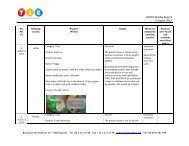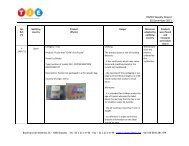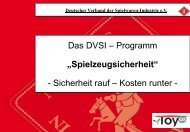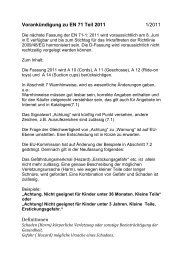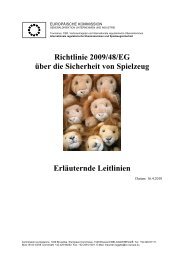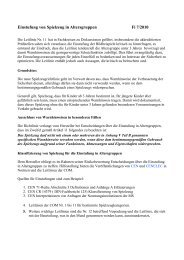You also want an ePaper? Increase the reach of your titles
YUMPU automatically turns print PDFs into web optimized ePapers that Google loves.
A.3 Material (see 4.1)<br />
<strong>EN</strong> <strong>71</strong>-1:<strong>2005+</strong><strong>A8</strong>:2009 (E)<br />
This requirement is intended to ensure that materials used in toys are new or, if reprocessed, so refined that<br />
the level of contamination of hazardous substances does not exceed that found in new material. There should<br />
be no infestation from animals or vermin.<br />
A.4 Assembly (see 4.2)<br />
These requirements are intended to address hazards associated with toys which have to be assembled before<br />
they can provide play but have not been properly assembled (e.g. ride-on toys which, for practical reasons,<br />
are shipped in an unassembled state).<br />
The requirements only apply to such assembly which is important from a safety point of view. The assembly of,<br />
for example, a model plastic kit is therefore not covered by this requirement.<br />
For evident reasons, it is not possible to establish any safety criteria for something that a child builds using, for<br />
example, building blocks.<br />
A.5 Flexible plastic sheeting (see 4.3)<br />
These requirements are intended to address the asphyxiation hazards that might be associated with thin<br />
flexible plastic film, should it cover the face of a child or be inhaled.<br />
Thin plastic sheeting may adhere to the child's mouth and nose making it impossible to breathe. If the<br />
thickness is greater than 0,038 mm, this risk is considered less significant.<br />
With respect to balloons, see A.16.<br />
A.6 Glass (see 4.5 and 5.7)<br />
These requirements are intended to address the hazards associated with broken glass – for example sharp<br />
edges.<br />
Accessible glass should as far as possible be avoided and should not be used unless necessary for the<br />
function of the toy.<br />
Porcelain is used in, for example, toy tea sets and should still be allowed for children of 36 months and over.<br />
The hazard associated with broken porcelain is well known.<br />
A.7 Expanding materials (see 4.6)<br />
This requirement is intended to address the hazards associated with certain toys which expand dramatically if<br />
swallowed. Fatal accidents have occurred when children have swallowed such toys.<br />
A.8 Edges (see 4.7)<br />
These requirements are intended to address the hazards associated with sharp edges on toys.<br />
The standard refers to metal and glass edges only as there is no test method available for plastic edges.<br />
Manufacturers should however, in designing toys and in the production of tooling, avoid sharp plastic edges<br />
as far as possible.<br />
77



